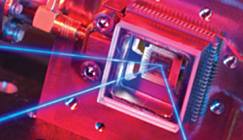 |
Date Announced: 15 Jan 2019
Results from NPL's latest research in photonics could open doors to new quantum technologies.
Teddington, UK – Researchers from the National Physical Laboratory (NPL) have revealed unusual qualities in light that could lead the way to entirely new electronic devices and applications. Light is used extensively in electronics for telecommunications and computing. Optical fibres are just one common example of how light is used to facilitate telephone calls and internet connections across the globe.
As outlined in Physical Review Letters, NPL researchers investigated how light can be controlled in an optical ring resonator, a tiny device that can store extremely high light intensities. Just as certain 'whispers' can travel around a whispering gallery and be heard the other side, in an optical ring resonator wavelengths of light resonate around the device.
The first-of-its-kind study uses optical ring resonators to identify the interplay of two types of spontaneous symmetry breaking. By analysing how the time between pulses of light varied and how the light is polarised, the team has been able reveal new ways to manipulate light.
For instance, usually light will obey what is known as 'time reversal symmetry', meaning that if time is reversed, light should travel back to its origin. However, as this research shows, at high light intensities this symmetry is broken within optical ring resonators.
Francois Copie, scientist on the project, explains: "When seeding the ring resonator with short pulses, the circulating pulses within the resonator will either arrive before or after the seed pulse but never at the same time."
As a potential application, this could be used to combine and rearrange optical pulses, for example in telecommunication networks.
The research also showed that light can spontaneously change its polarisation in ring resonators. This is as if a guitar string was initially plucked in the vertical direction but suddenly starts to vibrate either in a clockwise or an anticlockwise circular motion.
This has not only improved our understanding of nonlinear dynamics in photonics, helping to guide the development of better optical ring resonators for future applications (such as in atomic clocks for precise time-keeping), but will help scientists to better understand how we can manipulate light in photonic circuits in sensors and quantum technologies.
Pascal Del'Haye, Senior Research Scientist, NPL, said: "Optics have become an important part of our telecoms networks and computing systems. Understanding how we can manipulate light in photonic circuits will help to unlock a whole host of new technologies, including better sensors and new quantum capabilities, which will become ever more important in our everyday lives."
Find out more about the work NPL does to help accelerate quantum technologies
E-mail: info@npl.co.uk
Web Site: www.npl.co.uk
| © 2025 SPIE Europe |
|